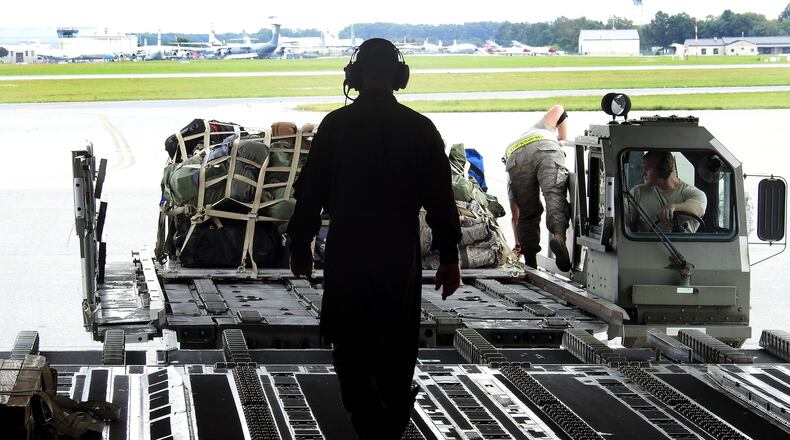This hurricane season, the C-17 Globemaster III transport jets began flying relief missions to Texas on Aug. 27 after Hurricane Harvey dumped a record of more than 50 inches of rainfall on parts of the Lone Star State.
RELATED: Wright-Patt C-17 hurricane relief flights expected to fly for weeks
Flown over six weeks, relief flights crisscrossed the United States and the Caribbean, and ended in mid-October with a final trek to Puerto Rico.
“It felt like a worldwide effort for us as were were flying from locations all over the United States,” said Lt. Col. Bryan Bailey, 89th Airlift Squadron director of operations and a C-17 pilot for the wing. At times, he said, “we didn’t know until we were airborne” where the plane would touch down on the multi-flight missions.
“We’ve been very busy for the last six weeks but this has all been in addition to everything to what we normally do,” he said, adding the unit had five air crews on three continents on Monday.
RELATED: Take an inside look at a Wright-Patterson hurricane relief flight mission to Florida
In late August, the Wright-Patt wing flew three missions to Texas, and carrying 130 passengers and 345,000 pounds of cargo, statistics show.
Hurricane Irma churned through the Caribbean in September and struck Florida, spurring four relief missions to southern peninsula state and separate trips to Puerto Rico and the Virgin Islands, and one combined mission to both U.S. territories. The air wing flew 275 passengers and nearly 560,000 pounds of cargo, statistics show.
Within weeks, Hurricane Maria slammed into Puerto Rico and the Virgin Islands, killing dozens, unleashing widespread destruction and leaving many without power since the last storm struck the island six weeks ago.
In missions tied to that relief effort, Wright-Patt C-17s flew nine relief missions, transported 211 passengers and nearly 900,000 pounds of aid flowing to Puerto Rico and the Virgin Islands, wing statistics show.
RELATED: Jets to fly over Miami Valley as they escape Hurricane Irma
This was the busiest hurricane relief flight season for Wright-Patt aircraft since September 2005, said Lt. Col. Cynthia Harris, a wing spokeswoman. The wing flew seven hurricane relief missions after Hurricane Katrina struck Louisiana and Mississippi in August 2005.
The Wright-Patt unit then flew a mixture of patient evacuations and relief aid in a geographically confined region, which made coordination easier, said Lt. Col. William Gorzynski, 89th Airlift Squadron commander.
Flying the C-141 Starlifter, the wing transported about 500 patients — mostly from long-term care facilities — out of the hard-struck Katrina disaster zone for treatment, said Lt. Col. Todd Mulhorn, commander of the 445th Aeromedical Evacuation Squadron. “That aircraft was a patient-moving machine,” he said.
A Wright-Patterson C-141 was the first plane to fly an aeromedical mission into the disaster zone after Katrina struck and the last to fly out prior to Hurricane Rita’s landfall in the Gulf Coast region weeks later, he said.
In September 2017, Wright-Patterson was a safe haven for dozens of military aircraft flying in from Florida and South Carolina while Irma battered the United States. The aircraft seeking refuge were a dozen Florida Air National Guard F-15 Eagles, nine Navy P-8 Poseidon and P-3 Orions anti-submarine planes based at Jacksonville, Fla., and six Air Force C-17s from Charleston, S.C.
The Ohio National Guard sent more than 200 troops to the Caribbean in the wake of Maria’s devastation.
About the Author
